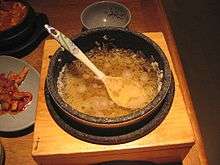Nurungji
| Nurungji | |
 A stone pot containing boiled nurungji bap | |
| Korean name | |
|---|---|
| Hangul | 누룽지 |
| Revised Romanization | nurungji |
| McCune–Reischauer | nurungji |
Nurungji (hangul: 누룽지) is a traditional Korean food made of scorched rice. After boiling and serving rice, a thin crust of scorched rice will usually be left in the bottom of the cooking pot. This yellowed scorched state is described as 'nureun' (눌은) in Korean and nurungji derives from this adjective.[1]
Nurungji can be eaten in its crisp state as a snack or as an aftermeal rice tea by adding hot water[2] or reboiled with water to make nureun bap (눌은밥) or nurungji bap (누룽지밥).[3] Nurungji in its broad sense also refers to the crisp crust that forms at the bottom of the pots and pans when cooking various rice dishes such as dolsot bibimbap (돌솥 비빔밥) and bokkeumbap.
History
Nurungji is traditionally known for its medicinal attributes. According to records in the 17th century medical book Dongui Bogam, nurungji was called chwigunban (취건반, 炊乾飯) and considered as a remedy "when food does not swallow easily, upsets the stomach and induces vomiting".[4] It is also being lauded as a well-being (sic) food in South Korea.[5]
South Korean companies made nurungji available in a various pre-packaged forms around the mid-2000s.[5] Besides sweet fried nurungji snacks and instant nurungji to make nureunbap, many nurungji flavor products were also developed such as candies and tea.[6] Nurungi is also being used as an ingredient for a variety of new dishes like nurungji baeksuk and nurungji pizza.[5]
Mentions of nurungji in folklore is common, the most famous being a folk song recognizing the difficulties of memorizing the Thousand Character Classic. The lines are changed from the original chant to a clever rhyme that loosely translates into "sky cheon (天), earth ji (地), nurungji in the gamasot (cauldron pot)". (Korean: "하늘 천, 따 지, 가마 솥에 누룽지").[7]
In other cultures

In Chinese cuisine, a very similar dish is called guoba; in Vietnamese cuisine, cơm cháy; in Japanese cuisine, okoge ; in Indonesian cuisine is called rengginang.
See also
References
- ↑ Kim (김열규), Yeolgyu (2004), The Fire of Koreans (한국인의 화) (in Korean), Seoul: Humanist (휴머니스트), p. 9, ISBN 89-89899-93-1
- ↑ Nurungji, Click Korea
- ↑ (Korean) Definition of nureunbap from the National Institute of the Korean Language
- ↑ (Korean) Nurungji is medicine, Gwangju Dream 2009-11-03
- 1 2 3 (Korean) Well-being food, nurungji is back!, Donga Ilbo 2009-10-19
- ↑ (Korean) Nurungji at Doosan Encyclopedia
- ↑ (Korean) "Sky cheon, earth ji", Hankook Ilbo 2010-05-28